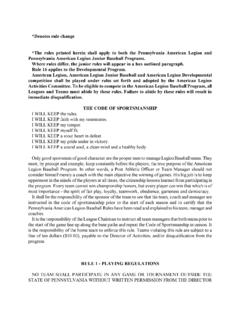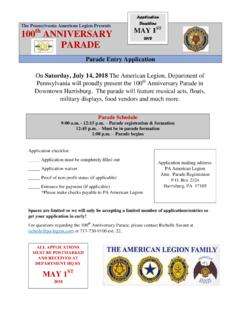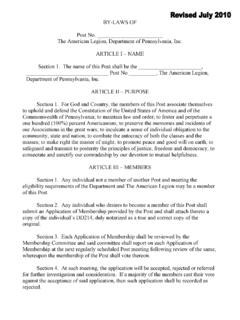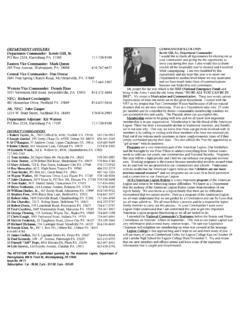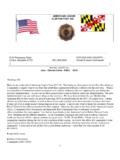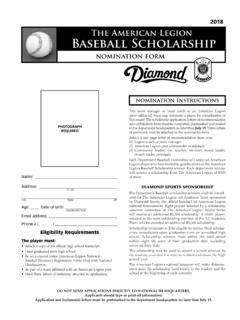Transcription of HOME ASSOCIATIONS, - Pennsylvania American Legion
1 home ASSOCIATIONS, A GUIDE TO ORGANIZATION AND OPERATION I. INTRODUCTION. While home Associations have existed in the Department of Pennsylvania for decades, they are not recognized or addressed by the national organization. The American Legion recognizes only Departments and Posts. Departments have authority to create intermediate bodies between the Posts and the Department to act as a liaison between such organizations and for the purpose of promoting the programs of the American Legion . County, District and Sectional units fall within this authority. Prior to the July 2004 Convention of The American Legion , Department of Pennsylvania , no formal authorization for the formation of home Associations existed within the Department of Pennsylvania . ARTICLE XI home ASSOCIATIONS, in Section 1 for the first time authorized Posts to form or continue home Associations provided they are organized and operated in accordance with the requirements of the standardized By Laws. Two (2) principal reasons exist for the creation of a home association .
2 They are insulation of the Posts and its assets from liability and the opportunity to have social or associate members who can contribute to a Post s financial success. If properly established and operated a home association can insulate the Post and the Post s assets from liability, primarily liability associated with liquor related operations. In order to accomplish this, the Post and home association must be separate and distinct entities so that the home association , Liquor Licensee, is not considered to be an agent or representative of the Post subject to its The Post may also have protection against contractual liability of the home association except in cases where it directly contracts with a third party, or on behalf of the home association , or where municipal services such as water are concerned. Liens for municipal services may be entered against the real estate regardless of the contracting entity. Under ARTICLE IV, Section 2 of the National Constitution of The American Legion , there can be no form or class of membership except an active membership.
3 Social memberships are precluded. Subject to requirements of the Internal Revenue Service, home Associations may have social members. Such members can increase the individuals participating in American Legion programs, further contributing to their success and enhance the financial well being of the Post/ home association through their payment of dues and participation in other fund raising activities of the Post/ home association . The provisions in ARTICLE XI of the standardized Post By Laws setting forth the authorization to form or continue a home association and establishing some requirements for the structure thereof, are designed to afford Posts protection for what is for most of our Posts their primary asset, the real estate, and to enable them to enhance their financial basis by attracting social members. II. ORGANIZATION. A. General Requirements. Section 2 of ARTICLE XI of the standardized Post By Laws requires all home Associations to be formed as a separate Non Stock Domestic Non Profit Corporation.
4 If not previously so incorporated, the home Association3 must be organized pursuant to the Pennsylvania Non Profit Corporation Law of 1988 as the same may be amended or substituted for. The national organization does not permit use of the designation American Legion or the symbol of the American Legion without the prior written consent of it. The number of the Post may be utilized in the name of the home association . For example, the home association could be named Legion Post _____ home association . The symbol of the (number) American Legion however may not be used in conjunction with home association materials without the prior written consent of the national organization. Under Section 3 of ARTICLE XI of the standardized Post By Laws, home Associations may have different classes of members. However, only those members, who are Legionnaires in good standing of the Post, may have voting rights or hold a position as Director, Executive Committeeman or other officer in the home association .
5 Non Post members may attend meetings, participate in discussions and generally participate in home association functions. Whether a home association elects to have members other than Post members must be considered in light of federal and state income tax requirements. (If the home association does not wish to have income tax exempt status, these need not concern it.) Each Post receiving a Charter from the American Legion does by virtue thereof, have federal income tax exempt status. When a Charter is issued, the Federal Employer s Identification4 Number for the Post is transmitted to the national organization and is then filed with the Internal Revenue Service. By virtue thereof, the Post enjoys federal income tax exempt status. However, no such automatic federal income tax exempt status exists for home Associations. The fact that a home association is organized as a non profit corporation does not in and of itself confer federal income tax exempt status on it. To obtain federal income tax exempt status, a home association must apply for the same.
6 Tax exempt status is controlled by Section 501 of the Internal Revenue Code. Today, depending on their organization and purposes, veterans organizations may be recognized as tax exempt under the following Sections of the Internal Revenue Code: 501 (c) (2), 501 (c) (4), 501 (c) (7), 501 (c) (8), 501 (c) (10), 501 (c) (23) and 501(c) (19). Of these, (c) (19) and (c) (7) are most likely to be considered. Before enactment of 501 (c) (19), War veterans organizations were grouped together with all other veterans organizations and recognized as exempt under 501 (c) (4) as social organizations. Their subsidiaries, home Associations, which were formed to maintain and operate their social facilities, were often recognized as exempt social clubs under 501 (c) (7). Section 501 (c) (19) applies only to veterans organizations and their related auxiliaries. The national organization and therefore Posts are federally tax exempt under Section 501 (c) (19).5 B. 501 (c) (19) Requirements.
7 In an organization exempt under 501 (c) (19), at least seventy five (75%) percent of the members of the organization must be past or present members of the Armed Forces of the United States (Veterans). Substantially all other members must be: a. Cadets or b. Spouses, widows or widowers, ancestors or lineal descendants of veterans or Cadets. Cadets include students in college or University ROTC programs or at armed services academies. Substantially all means ninety (90%) percent. Of the twenty five (25%) percent of the members that do not have to be veterans, ninety (90%) percent have to be Cadets or spouses, widows or widowers, ancestors or lineal descendents of veterans or Cadets. Members of the Auxiliary and Sons could therefore make up to twenty five (25%) of the home association Membership under 501 (c) (19). Only of the organization s total membership may consist of individuals who are not veterans, Cadets or spouses, widows or widowers, ancestors or lineal descendants of veterans or Cadets.
8 Anentity organized as a 501 (c) (19) tax exempt organization may permit social members or friends membership privileges without jeopardizing its exempt status only if it limits the number of such members to no more than of its total membership. Ifthe entity fails to meet the membership requirements contained in 501 (c) (19), it will no longer qualify for exemption. The6 entity may include non veterans sons, daughters, and other related individuals as part of its membership, so long as they, along with any other non veteran class of membership, make up no more than of the entity s membership. In addition, the organization must be operated for one or more of the following purposes: (a) Promoting the social welfare of the community (b) Assisting needy and disabled veterans, widows or orphans of deceased veterans (c) Providing entertainment, care and assistance to hospitalized veterans or members of the Armed Forces of the United States (d) Perpetuating the memory of veterans and comforting their survivors (e) Conducting programs for religious, charitable, scientific, literary or educational purposes (f) Sponsoring or participating in patriotic activities (g) Providing insurance benefits to members or members dependents and (h) Providing social and recreational activities for members.
9 Also, significant for Section 501 (c) (19) organizations is that they may allow acceptance of charitable gifts and bequests. Contributions may be deductible to the donor pursuant to 26 170 (c) (3) of the Internal Revenue Code of 1954, as amended, thereby encouraging donations. Section 170 (c) (3) reads as follows: Section 170. Charitable, etc., Contributions and (a) Allowance of Deduction. (1) General Rule. There shall be allowed as a deduction any charitable contribution (as defined in subsection (c)) payment of which is made within the taxable year ..(c) Charitable Contribution Defined. For purposes of this section the term Charitable Contribution means a contribution or gift to or for the use of (3) A Post or organization of war veterans or an auxiliary unit or society of, or trust or foundation for, any such Post or organization (A) Organized in the United States or any of its possessions, and (B) No part of the net earnings of which inures to the benefit of any private shareholder or individual.
10 Note the organization must be one ninety percent (90%) of the members of which are War Veterans not merely veterans . War Veterans are those serving during a period of war, the periods are: A. April21, 1898, through July 4, 1902 B. April 6, 1917, through November 11, 1918 C. December 7, 1941, through December 31, 1946 D. June 27, 1950, through January 31, 1955 E. February 28, 1961, through May 7, 1975, in the case of a veteran who served in the Republic of Vietnam during that period 8 F. August 5, 1964, through May 7, 1975 and G. August 2, 1990, and ending on the date prescribed by Presidential Proclamation or by law. C. 501 (c) (7) Requirements. The other section many home Associations seek to qualify for federal income tax exempt status under is 501 (c) (7). 501 (c) (7) exempts from tax social clubs that are organized and operated primarily for pleasure, recreation and similar non profitable purposes. In keeping with this purpose, non member income from all sources is limited and may be taxed as unrelated business income.



